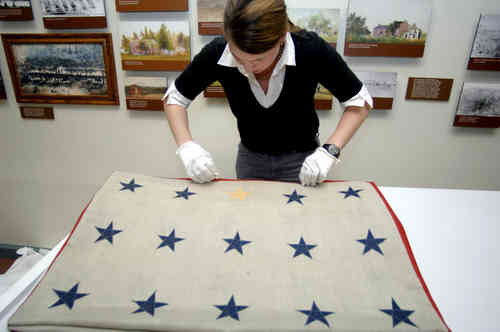Courtesy of Fredericksburg.Com
20 November 2006
By CATHY DYSON
As an intern for the National Park Service, Kati Singel uncovered a mystery when she was working on one of those glamorous projects interns tend to get.
Singel was doing inventory in the basement of the Chancellorsville Battlefield Visitor Center. She was supposed to make sure the 10,000 items in storage were packaged correctly.
She came across a service flag–a 7-foot long banner decorated with 49 blue stars and one gold one. She knew flags shouldn’t be folded as this one was because creases lead to wear and tear.
But that wasn’t the only thing amiss.
Singel, a history major at the University of Mary Washington, knew service flags were hung during World War I and II to honor members of the military.
They became popular again after 9/11.
But she never heard of them in use during the Civil War and everything at the Chancellorsville center should be from that era.
The intern began her “Singel-minded” pursuit to learn all she could about item “FRSP 141.” (“FRSP” stands for Fredericksburg and Spotsylvania National Military Park.)
With the help of park historians, librarians and a church archivist–and after a trip to the Arlington National Cemetery — Singel unraveled the story behind the flag that had been tucked away in a drawer almost 70 years.
Remembering ‘The Great War’
The label said the service flag was donated to the Park Service in 1937, and that it had once hung in St. George’s Episcopal Church in Fredericksburg.
Singel figured the flag honored those who fought in what the old-timers call “The Great War.”
She contacted Trip Wiggins, archivist at St. George’s, who found nothing in church minutes about it.
“I was just as surprised about it as the Park Service was,” he said.
He met with Barbara Willis at the Central Rappahannock Regional Library, and the two looked through files, old newspapers and parish records.
They checked the list of 109 Fredericksburg-area men killed in World War I against names in the church records.
The only one from St. George’s–and the first man from Fredericksburg to die in the war–was Douglas Hamilton Knox Jr.
Knox came from “one of Fredericksburg’s oldest and most prominent families,” according to Park-Service literature.
His father fought with the Confederates, and his grandfather was an important businessman before the Civil War.
His family lived at 1200 Princess Anne St., the current site of the Kenmore Inn.
Knox was a 24-year-old shipping clerk before he enlisted in the Marine Corps. He was with the 6th Marines, 2nd Division during the bloody Battle of Belleau Wood in June 1918.
The 2nd Division was supposed to take the wood, but crossing an open wheat field swept from end to end by German machine gun fire was “a murderous trek,” according to the First World War Web site.
The casualties the first day were the highest, to date, in Marine Corps history. The Germans fiercely defended their position, and control shifted six times before the Germans were expelled, the Web site states.
By the end of the 20-day battle, 1,811 Americans were dead.
Knox was one of them.
He was taken to a field hospital on June 14, 1918, and never regained consciousness.
He was buried in a Paris cemetery reserved for Americans, “on a lovely hillside overlooking the city,” according to an August 10, 1918, story in The Free Lance.
Three years later, he came home to the United States and was reinterred at Arlington National Cemetery.
Remembering Veterans Day
Singel visited Arlington. Her photo of Knox’s tombstone is on display at the Fredericksburg Battlefield Visitor Center, off Lafayette Boulevard, along with the service flag.
Singel and Chief Historian John Hennessey put the exhibit together this week, in honor of Veterans Day. It will be on display through December.
The exhibit includes names of the other St. George’s members who served in World War I.
The 49 who came back alive are represented by blue stars. There’s a gold star in the center of the top row for Knox.
The flag and an engraved roll of honor were hung over the altar of St. George’s in November 1918, according to The Daily Star.
The next year, the Fredericksburg American Legion Post was dedicated in memory of Knox, as well as Harry L. Bowen and Mercer W. Franklin, who also died in the first great war.
Little is known about what happened to the service flag in the years that followed. But in 1937, Lilias Hamilton Scott, wife of John F. Scott, donated the flag to the Fredericksburg and Spotsylvania National Military Park.
It was cataloged as a “Civil War service flag” until Singel unfolded it a few weeks ago.
Park historians still don’t know why the flag was given to the local park system–an entity that specializes in Civil War memorabilia.
Chancellorsville park historian Janice Frye, who was impressed by Singel’s search for the truth, could only wonder.
“Was it because this is a military park and it seems the appropriate place? Or is there some other connection? Don’t know,” she said. “That’s what makes history fun.”
KNOX, DOUGLAS HAMILTON
PVT 79TH CO 6TH MARINE 2ND DIV
DATE OF DEATH: 06/18/1918
BURIED AT: SECTION WH EU SITE 3860
ARLINGTON NATIONAL CEMETERY
Michael Robert Patterson was born in Arlington and is the son of a former officer of the US Army. So it was no wonder that sooner or later his interests drew him to American history and especially to American military history. Many of his articles can be found on renowned portals like the New York Times, Washingtonpost or Wikipedia.
Reviewed by: Michael Howard


